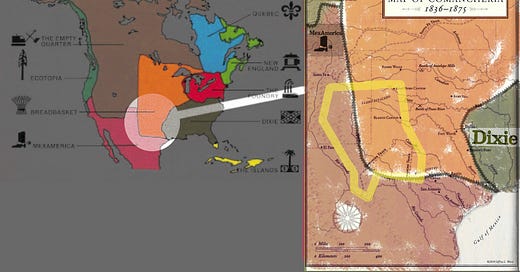“The final destruction of the last of the hostile tribes would not take place for a few more years. Time would be yet required to round them all up, or starve them out, or exterminate their sources of food, or run them to ground in shallow canyons, or kill them outright…
The white men were… ascending to the turreted rock towers that gated the fabled Llano Estacado - of West Texas, a country populated by the most hostile Indians on the continent… the Llano was a place of extreme desolation, a vast, trackless, and featureless ocean of grass where white men became lost and disoriented and died of thirst; a place where the imperial Spanish had once marched confidently forth to hunt Comanches, only to find that they themselves were the hunted, the ones to be slaughtered.
…
The Comanches had stopped cold the northward advance of the Spanish empire in the eighteenth century - an empire that had, up to that point, easily subdued and killed millions of Indians in Mexico and moved at will through the continent.
- Empire of the Summer Moon
Right panel - map of Comancheria from Empire of the Summer Moon. with overlay of the Nine Nations of North America. Inset highlight is the territory of the Quahadi Commanche - the most feared and unfriendly to Anglo of Commanche tribes - last led by the great war chief Quanah Parker before their final defeat.
The Commanche ruled the territory that later became the boundaries of MexAmerica, the Empty Quarter and The Breadbasket. No surprise - the Breadbasket has a natural border where the land is no longer fertile - prairie gives way to desert and mountains. The fierce commanche pushed the northern boundary of MexAmerica north - past the old Santa Fe trail and against Denver. This region was a big go around zone in the Commanche heyday. In other words, the seams of the Nine Nations here fall in this odd way because this was the last territory to be integrated rather than as a confluence. For a long time this was a hole in the Anglo-American nine nations. The land resists integration and conquest.
Denver, the capital of the Empty Quarter, is similar in some way to Indianapolis - recall that Indianapolis’s strength is that it is a border town where the Foundry, Breadbasket and Dixie nations meet. Denver sits at the nexus The Breadbasket, MexAmerica and the Empty Quarter - but Denver’s strength does not lie in its role as a pivotal trade center of three economic regions. Rather, Denver’s strength today is as a central nerve for the military industrial complex. A lot of major arms or aerospace contractors like Boeing, Honeywell, or Raytheon have established a great Denver metropolis - including sub-centers like Colorado Springs - as well as several large military bases and the Air Force Academy. Some of the weapons these industries produced are named after these tribes, like the Commanche attack helicopter. Denver was established because it was the southernmost safe haven for going around the Commanche. Denver borders a conflict zone. The history of the once secretive Rocky Flats nuclear facility and testing sites to the west in Nevada or New Mexico seem relevant to mention. The fault line of MexAmerica and The Breadbasket corresponds to the hot-button (and decades running) fight over humans crossing borders.
Seven men were killed in the raid…. the victims were stripped, scalped, and mutilated. Some had been beheaded and others had their brains scooped out. Their fingers, toes, and private parts had been cut off and stuck in their mouths… Tortured upon each exposed abdomen had been placed a mass of live coals. One wretched man was found chained between two wagon wheels and, a fire having been made, been slowly roasted to death - ‘burnt to a crisp. - Empire of the Summer Moon
A land fit to build modern weapons of war? The line drawn here links the context of a region where the fiercest native tribes and nastiest Indian-Anglo war fighting went down to the present day context of this region as a highly militarized economic region - as well as a central nerve in culture war conflict by way of north south immigration.
The scrublands, open seas of prairie and vast blue skies of Texas gives birth to fierce free spirits. Its wild and hot as hell down there to this day. Modern Americans forget Texans like Sam Houston, who fiercely opposed slavery and sought free reconciliation with native tribals.[1] The Commanche and their disinterest in integration with the Anglo-Indo America around them is today represented by the independent mind of Texas - a state with the right to secede from the Union built into its constitution. (Were Texas ever to secede, the central square of the chessboard in the northern continent’s national security interests would be irrevocably compromised - the West Coast would soon fall fully to Chinese and Pacific rim influence and the East Coast to European interests. Texas would have its hands full protecting and regulating its southern border while the breadbasket heartland would be populated with South and Central American immigrants going around Texas on their way north or south the way others did Comancheria east west.) A state famed for its liberal use of the death penalty and citizen gun play. The other nations (especially New Englanders) may perceive Texans as ornery or pigheaded in their plain-spoken expressions of independence, much as the Commanche were kept at a wary distance by the Sioux, Apache and Cherokee nations around them.
[1] As always its complicated. Sam Houston despised slavery | AP News
References
Garreau, Joel. The Nine Nations of North America. 1st ed., Avon Books, 1981.
Gwynne, S C. Empire of the Summer Moon. 1st ed., Scribner, 2010



